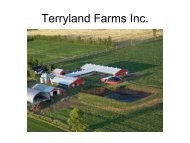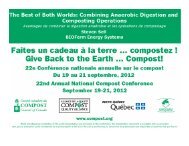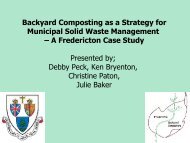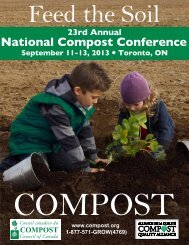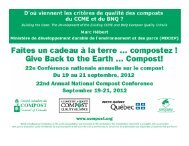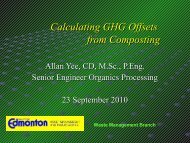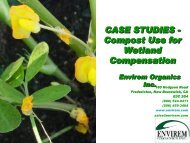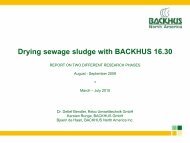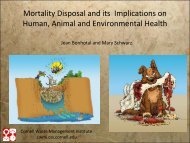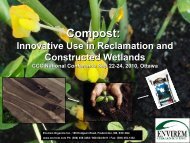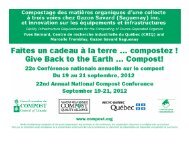Calculating Carbon Emission Effect of Waste Management Activities
Calculating Carbon Emission Effect of Waste Management Activities
Calculating Carbon Emission Effect of Waste Management Activities
Create successful ePaper yourself
Turn your PDF publications into a flip-book with our unique Google optimized e-Paper software.
<strong>Calculating</strong> the <strong>Carbon</strong> Footprint<br />
<strong>of</strong> Various Municipal<br />
<strong>Waste</strong> <strong>Management</strong> Practices<br />
Allan Yee, CD, M.Sc., P.Eng.<br />
Senior Engineer Organics Processing<br />
5 February 2013<br />
<strong>Waste</strong> <strong>Management</strong> Services
Outline<br />
Municipal <strong>Waste</strong> <strong>Management</strong> Decision Making<br />
IAW the 4 Rs<br />
<strong>Waste</strong> <strong>Management</strong> <strong>Carbon</strong> <strong>Emission</strong> <strong>Effect</strong>s<br />
<strong>Carbon</strong> Footprint <strong>of</strong> Landfill Disposal<br />
<strong>Waste</strong> Recovery Example: LFG Capture<br />
<strong>Waste</strong> Recycling/Reuse Example: Composting<br />
Residential Recycling Discussion<br />
<strong>Waste</strong> Reduction Example: Grasscycling<br />
Summary and Conclusions<br />
<strong>Waste</strong> <strong>Management</strong> Services
Higher Preference<br />
<strong>Waste</strong> <strong>Management</strong> Hierarchy: the 4 Rs<br />
Reduce<br />
Reuse<br />
Recycle<br />
Recover
<strong>Carbon</strong> <strong>Emission</strong> <strong>Effect</strong>s <strong>of</strong> <strong>Waste</strong><br />
<strong>Management</strong> Practices<br />
Every activity/process has a carbon footprint that can<br />
be measured and/or calculated.<br />
The carbon footprint (GHG emissions) <strong>of</strong> waste<br />
management activities comes from:<br />
Activity/process energy inputs;<br />
Degradation <strong>of</strong> organic materials during activity;<br />
Production <strong>of</strong> energy/energy containing substances.<br />
Comparison <strong>of</strong> carbon footprints <strong>of</strong> alternative waste<br />
practices.<br />
<strong>Waste</strong> <strong>Management</strong> Services
Landfill Gas Generation<br />
<strong>Waste</strong> <strong>Management</strong> Services
Landfill Gas <strong>Emission</strong>s<br />
Disposal and degradation <strong>of</strong> organic materials in a landfill<br />
under anaerobic conditions will generate GHGs.<br />
CH 4 is main GHG <strong>of</strong> concern as CO 2 is biogenic.<br />
Landfill emissions are the biggest contributor to the<br />
carbon footprint <strong>of</strong> most municipal waste management<br />
systems. <strong>Emission</strong>s from upstream extraction and<br />
consumption <strong>of</strong> fossil fuels in collecting waste plus<br />
energy inputs into landfilling efforts are relatively minor<br />
in comparison.<br />
6% <strong>of</strong> total CH 4 emissions worldwide are attributed to<br />
landfills.<br />
<strong>Waste</strong> <strong>Management</strong> Services
Methane Generation Potential, L o<br />
L o = amount <strong>of</strong> CH 4 that can theoretically be produced<br />
from landfilling one tonne <strong>of</strong> waste<br />
L o = MCF x DOC x DOC f x F x (16/12) x 1000 kgs<br />
CH 4 /tonne waste<br />
Where L o = CH 4 generation potential, kgs/tonne <strong>of</strong> waste<br />
MCF = CH 4 correction factor, fraction<br />
DOC = degradable organic carbon, t C/t <strong>of</strong> waste<br />
DOC f = fraction <strong>of</strong> DOC that dissimilates under landfill conditions<br />
F = fraction <strong>of</strong> CH 4 in landfill gas<br />
16/12 = stoichiometric factor for conversion <strong>of</strong> CH 4 to carbon<br />
<strong>Waste</strong> <strong>Management</strong> Services
Time Distribution <strong>of</strong> L o<br />
Mass <strong>of</strong> material landfilled M, times L o yields<br />
the maximum amount <strong>of</strong> methane that can be<br />
generated from that material.<br />
Applying a first order decay function (e -kt ) to<br />
M x L o will give a time distribution to the<br />
emissions.<br />
Resulting relationship commonly known as<br />
Scholl Canyon Model.<br />
<strong>Waste</strong> <strong>Management</strong> Services
Summation <strong>of</strong> Individual FOD Curves Over Time<br />
Time period <strong>of</strong><br />
active landfilling<br />
CH 4<br />
<strong>Emission</strong>s<br />
(Q)<br />
Individual first order decay<br />
(FOD) time distribution<br />
curve for methane<br />
generation<br />
0 1 2<br />
Time (Yrs)<br />
100<br />
∞
Numerical Approximation <strong>of</strong> FOD<br />
Model Equation<br />
n<br />
Qt = ∑ 2k L o M i e -kt i<br />
i=1<br />
Where Q t = total LFG emission rate, volume/time<br />
n = total time periods <strong>of</strong> waste placement<br />
k = methane generation rate constant, time -1<br />
L o = methane generation potential, volume/mass <strong>of</strong> waste<br />
t i = age <strong>of</strong> the ith section <strong>of</strong> waste, time<br />
M i = mass <strong>of</strong> wet waste, placed at time i<br />
<strong>Waste</strong> <strong>Management</strong> Services
<strong>Waste</strong> Recovery Example:<br />
Landfill Gas Collection<br />
<strong>Waste</strong> <strong>Management</strong> Services
Landfill Gas Collection Systems<br />
Network <strong>of</strong> interconnected gas extraction wells<br />
installed in capped portions <strong>of</strong> landfill site.<br />
Suction blowers capture and transport LFG from<br />
wells to a central point where gas is processed for<br />
straight combustion (flaring) or energy recovery<br />
(power, CHP, CNG, etc.).<br />
Typical 75% capture efficiency for collection<br />
systems: comparisons <strong>of</strong> CH 4 captured vs. generated.<br />
Further 10% oxidation <strong>of</strong> CH 4 emissions through the<br />
cover system <strong>of</strong> a landfill.<br />
<strong>Waste</strong> <strong>Management</strong> Services
Edmonton’s LFG Capture System<br />
In operation at Clover Bar Landfill since 1992,<br />
current LFG flow is about 65,000 standard m 3 /day,<br />
with average CH 4 content <strong>of</strong> 52%.<br />
2011 data:<br />
City Scholl Canyon model calculated 8,122 tonnes CH 4<br />
generated.<br />
Capital Power recorded 6,384 tonnes CH 4 captured.<br />
Net emissions difference, counting flaring/power<br />
generation and cover oxidation = 32,848 tonnes CO 2 -e.*<br />
<strong>Waste</strong> <strong>Management</strong> Services<br />
*Using a GWP <strong>of</strong> 21 for CH 4
<strong>Waste</strong> Recycling/Reuse Example:<br />
Composting<br />
<strong>Waste</strong> <strong>Management</strong> Services
<strong>Carbon</strong> Footprint <strong>of</strong> Composting<br />
<strong>Carbon</strong> footprint = emissions from:<br />
Process <strong>of</strong> composting [mass <strong>of</strong> material composted x<br />
composting emission factors];<br />
Upstream extraction and consumption <strong>of</strong> the energy inputs into<br />
the operation [quantities <strong>of</strong> fuel used x respective emission<br />
factors]; and<br />
Landfilling <strong>of</strong> residuals from process [mass <strong>of</strong> residuals x L o ].<br />
Differences between above and emissions from a<br />
baseline [landfilling <strong>of</strong> materials composted] are the<br />
emission reductions [<strong>of</strong>fsets] from the operation.<br />
<strong>Waste</strong> <strong>Management</strong> Services
Basic Composting System Boundary, Inputs<br />
and Outputs<br />
<strong>Waste</strong> Production<br />
(households,<br />
commercial)<br />
<strong>Waste</strong> collection,<br />
sorting,<br />
transportation<br />
Sorting<br />
Landfill)<br />
Recycle<br />
Aerobic Conversion<br />
Compost<br />
On site use <strong>of</strong><br />
electricity<br />
Electricity from grid<br />
On site use by<br />
equipment<br />
Fuel (Diesel)<br />
System Boundary Limit<br />
End User<br />
Adapted from CDM (2005)
Windrow Composting
Baseline <strong>Emission</strong>s<br />
E baseline = [M delivered x (MCF)(DOC)(DOC F )(F)(16/12) –R][1-OX][GWP methane ]<br />
Where E baseline = CH 4 emissions from landfilled waste in CO 2 equivalent (tonnes)<br />
M delivered<br />
MCF<br />
DOC<br />
DOC F<br />
= waste delivered to composting facility (tonnes)<br />
= methane correction factor<br />
= 1 for managed landfills (IPCC default)<br />
= degradable organic fraction <strong>of</strong> waste (tonne C/tonne waste)<br />
= 0.19 for Alberta (calculated using Environment Canada data)<br />
= fraction <strong>of</strong> degradable organic carbon dissimilated<br />
= 0.77 (IPCC default)<br />
F = fraction <strong>of</strong> LFG that is CH 4 , assumed to be 0.5<br />
16/12 = stoichiometric factor (molecular weight fraction <strong>of</strong> CH 4 /C)<br />
R = recovered landfill gas at baseline landfill (measured)<br />
OX = landfill oxidation factor<br />
= 0.1 for landfills with soil or compost covers (IPCC default)<br />
GWP methane = global warming potential <strong>of</strong> methane <strong>of</strong> 25 (IPCC default)
Diesel Usage <strong>Emission</strong>s<br />
E diesel = (F CO2 )(V diesel ) + (F CH4 )(V diesel )(GWP CH4 ) + (F N2O )(V diesel )(GWP N2O )<br />
Where E diesel = direct GHG emissions from diesel combusion, kg CO 2 -e<br />
F CO2<br />
= emission factor for CO 2 emissions from diesel combustion<br />
= 2.730 kg CO 2 per m 3 (CAPP value)<br />
V diesel = volume <strong>of</strong> diesel gas consumed (m 3 )<br />
F CH4<br />
= emission factor for CH 4 emissions from diesel combustion<br />
= 0.000133 kg CH 4 per m 3 (CAPP value)<br />
GWP CH4 = global warming potential for CH 4 <strong>of</strong> 21 (IPCC default)<br />
F N2O<br />
= emission factor for N 2 O emissions from diesel combustion<br />
= 0.0004 kg N 2 O per m 3 (CAPP value)<br />
GWP N2O = global warming potential for N 2 O <strong>of</strong> 310 (IPCC default)
Diesel Production <strong>Emission</strong>s<br />
E diesel,p = (F CO2,p )(V diesel ) + (F CH4,p )(V diesel )(GWP CH4 ) + (F N2O,p )(V diesel )(GWP N2O )<br />
Where E diesel,p = upstream GHG emissions from diesel production, kg CO 2 -e<br />
F CO2,p<br />
= emission factor for CO 2 emissions from diesel combustion<br />
= 0.138 kg CO 2 per m 3 (CAPP value)<br />
V diesel = volume <strong>of</strong> diesel gas consumed (m 3 )<br />
F CH4<br />
= emission factor for CH 4 emissions from diesel production<br />
= 0.0109 kg CH 4 per m 3 (CAPP value)<br />
GWP CH4 = global warming potential for CH 4 <strong>of</strong> 21 (IPCC default)<br />
F N2O<br />
= emission factor for N 2 O emissions from diesel production<br />
= 0.000004 kg N 2 O per m 3 (CAPP value)<br />
GWP N2O = global warming potential for N 2 O <strong>of</strong> 310 (IPCC default)
ECF Example<br />
<strong>Waste</strong> <strong>Management</strong> Services
Collected<br />
Mixed<br />
Residential<br />
MSW<br />
Pre-processing<br />
(sorting)<br />
110,000 tonnes<br />
Edmonton Composting Facility System<br />
Boundary, Inputs and Outputs<br />
ECF –<br />
mechanical<br />
plant<br />
Primary Residuals 14,000 tonnes, 13.4%organic<br />
Secondary Residuals 15,000 tonnes, 45.3%organic<br />
On-site power<br />
use<br />
On-site natural<br />
gas use<br />
Electricity from<br />
grid<br />
Natural gas<br />
Residues to<br />
landfill w/ no<br />
LFG<br />
Collection<br />
14,000,000 kWh<br />
29,600 GJ<br />
Compost curing<br />
On-site diesel<br />
use<br />
Diesel fuel<br />
483,900 L<br />
10,000 tonnes<br />
Collected waste<br />
wood<br />
On-site waste<br />
wood chipping<br />
On-site<br />
gasoline use<br />
On-site<br />
propane use<br />
Gasoline<br />
Propane<br />
1,280 L<br />
1,740 m 3<br />
Dewatered<br />
municipal<br />
biosolids<br />
Biosolids/wood<br />
chip mixing<br />
Screening cured<br />
compost<br />
Tertiary Residuals 2,000 tonnes, 45.3%organic<br />
Residues to<br />
landfill w/ LFG<br />
collection<br />
Biosolids/wood<br />
chip composting<br />
System Boundary<br />
Compost sales<br />
to end users
Calculation <strong>of</strong> <strong>Emission</strong>s and Offsets<br />
for the ECF*<br />
Baseline emissions from landfilling feedstock =<br />
263,340 tonnes CO 2 -e.<br />
Project <strong>Emission</strong>s <strong>of</strong> 50,123 tonnes CO 2 -e:<br />
Composting = 12,900 tonnes CO 2 -e;<br />
On-site combustion and upstream processing/extraction for<br />
power/diesel/natural gas/propane/gasoline = 16,206 tonnes<br />
CO 2 -e; and<br />
Landfill disposal <strong>of</strong> residuals = 21,017 tonnes CO2-e.<br />
Net calculated <strong>of</strong>fsets = 213,217 tonnes CO 2 -e.<br />
<strong>Waste</strong> <strong>Management</strong> Services<br />
*2007 IPCC GWP = 25 for CH 4 , 298 for N 2 O
Residential Recycling<br />
Discussion<br />
<strong>Waste</strong> <strong>Management</strong> Services
Residential Recycling
<strong>Waste</strong> <strong>Management</strong> Services
<strong>Waste</strong> <strong>Management</strong> Services
Complexities <strong>of</strong> <strong>Carbon</strong><br />
Accounting in Recycling<br />
Cannot assume away transportation component emissions.<br />
<strong>Carbon</strong> footprint <strong>of</strong> end use <strong>of</strong> recycled materials must be<br />
compared against:<br />
Avoided emissions from landfilling <strong>of</strong> organic materials; and<br />
<strong>Carbon</strong> footprint for displacement <strong>of</strong> virgin materials in end<br />
manufacturing.<br />
Municipalities only play small part in the long recycling chain.<br />
Long chain <strong>of</strong> custody for diversity and grades <strong>of</strong> recycled<br />
materials from initial separation to final recycled use means no<br />
one player will likely have all info necessary for calculation.<br />
Fast moving/changing markets for recyclable materials.<br />
<strong>Waste</strong> <strong>Management</strong> Services
What proportion <strong>of</strong> the<br />
carbon footprint <strong>of</strong><br />
collection and sorting<br />
is assigned to what<br />
commodities
Newsprint Recycling Example<br />
ONP6 vs. ONP8:<br />
Less “outthrows” in ONP8, but greater effort required.<br />
ONP8 however, can likely go to regional/NA mills vs.<br />
overseas where it may be economical to re-sort the paper.<br />
MRF operator’s incentives likely only returns vs. cost<br />
(sorting and transportation), not carbon footprint.<br />
Transportation costs disproportionate to actual GHG<br />
emissions generated.<br />
Downstream processing/manufacturing emission factors<br />
(e.g., power) likely unknown to MRF operator.<br />
<strong>Waste</strong> <strong>Management</strong> Services
<strong>Waste</strong> Reduction Example:<br />
Grasscycling<br />
<strong>Waste</strong> <strong>Management</strong> Services
<strong>Carbon</strong> Footprint <strong>of</strong> Grasscycling<br />
<strong>Carbon</strong> footprint <strong>of</strong> grasscycling is due to<br />
emissions from:<br />
Production <strong>of</strong> potable water and chemical fertilizers<br />
applied to a lawn to grow grass; and<br />
Use and production <strong>of</strong> any fuels consumed in cutting<br />
grass.<br />
<strong>Carbon</strong> footprint <strong>of</strong> grasscycling can be compared<br />
to carbon footprint <strong>of</strong> its alternatives.<br />
<strong>Waste</strong> <strong>Management</strong> Services
The Residential Grass Cultivation System<br />
System Boundary<br />
Water<br />
Sunlight<br />
Fertilizer<br />
Grow Grass<br />
Lawnmower<br />
Energy<br />
Cut Grass<br />
Option 3: Grasscycling<br />
Grass Clippings<br />
Energy Inputs into Landfilling Operation<br />
Option (Baseline) 1: Landfilling Grass<br />
Clippings<br />
Landfill w/o LFG<br />
Collection<br />
Option (Baseline) 2: Composting Grass<br />
Clippings<br />
Composting<br />
Operation<br />
Energy Inputs into Composting<br />
Operation
Numbers for Comparative Calculation<br />
180,000 single family households @ 250 m 2 lawn<br />
size, 354 kgs yearly production <strong>of</strong> clippings.<br />
Average cutting every 2 weeks April-October w/<br />
gasoline powered mowers, 0.2 L gasoline/cutting.<br />
No watering <strong>of</strong> lawns, displacement <strong>of</strong> 25%<br />
fertilizer (28-4-8) requirements on 50% <strong>of</strong> lawns.<br />
<strong>Waste</strong> <strong>Management</strong> Services
Alternative Baseline Scenario 1:<br />
Landfill Disposal<br />
Residential collection <strong>of</strong> clippings in 6.5 tonne<br />
payload vehicles, round trip distance <strong>of</strong> 80 kms to<br />
transfer station, 3.5 L diesel/km.<br />
Transfer haul to landfill w/o LFG collection in 20<br />
tonne payload long haul vehicles, round trip distance<br />
<strong>of</strong> 180 kms, 0.6 L diesel/km.<br />
Pro-rated energy inputs (power, natural gas, diesel)<br />
into landfill operation.<br />
GHG emissions from landfilling <strong>of</strong> grass.<br />
<strong>Waste</strong> <strong>Management</strong> Services
Alternative Baseline 2:<br />
Central Composting<br />
Residential collection as per landfilling<br />
baseline.<br />
Gross emission factors for centralized<br />
composting as per City <strong>of</strong> Edmonton<br />
operation.<br />
<strong>Waste</strong> <strong>Management</strong> Services
Metric Tonnes CO2<br />
Relative GHG <strong>Emission</strong>s for Residential Grass<br />
<strong>Management</strong> in Edmonton<br />
140000<br />
129,037 tonnes CO2-e<br />
120000<br />
100000<br />
80000<br />
60000<br />
40000<br />
20,777 tonnes CO2-e<br />
20000<br />
1,758 tonnes CO 2 -e<br />
0<br />
Grasscycling Composting Disposal to Landfill
Hierarchy Comparison for<br />
Residential Grass <strong>Management</strong><br />
If the right-most bar on the graph (129,037 tonnes<br />
CO 2 -e) indicates methane emissions that would result<br />
from landfilling 63,270 tonnes <strong>of</strong> waste <strong>of</strong> grass<br />
clippings, then emissions could be reduced by:<br />
96,777 tonnes CO 2 -e with a 75% efficient LFG capture<br />
system, a waste recovery activity<br />
108,260 tonnes CO 2 -e by composting, a waste recycling<br />
activity<br />
127,279 tonnes CO 2 -e by grasscycling, a waste reduction<br />
activity<br />
<strong>Waste</strong> <strong>Management</strong> Services
Summary and Conclusions<br />
As per the grasscycling example, in general, the higher a<br />
practice is in the waste management hierarchy, the lower the<br />
carbon footprint.<br />
Logical and accepted methodologies for determining carbon<br />
footprint <strong>of</strong> various waste management practices.<br />
Difficult to accurately quantify emission reductions from<br />
residential recycling.<br />
Numbers used in carbon footprint calculations (emission<br />
factors, GWP values) will change, more important is the chain<br />
<strong>of</strong> logic used to determine how to do the calculation.<br />
<strong>Waste</strong> <strong>Management</strong> Services
Questions<br />
<strong>Waste</strong> <strong>Management</strong> Services



